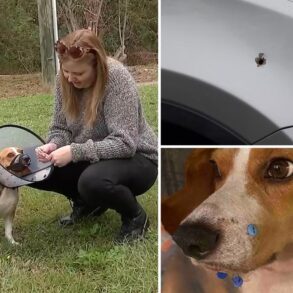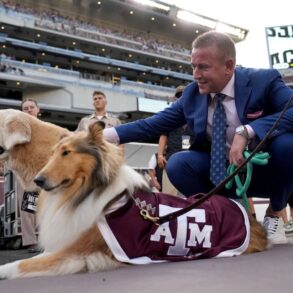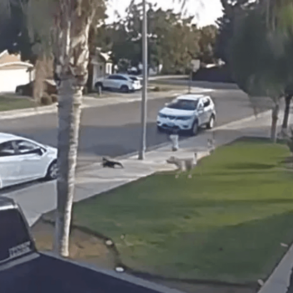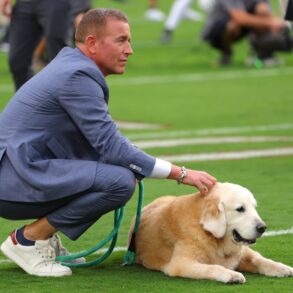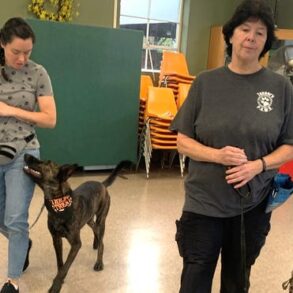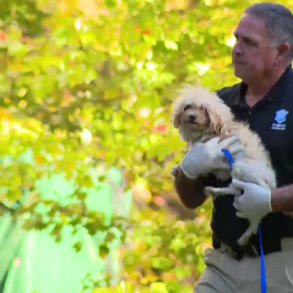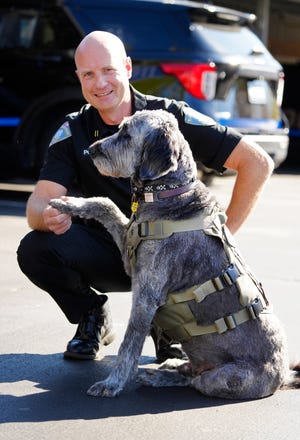
Licorice, the Blue Ash Police Department’s therapy dog, is somewhat of a failure.
Of course, anyone who meets the gentle, obedient boy would never call him that. He just so happened to fail his test to become a service dog. But this “failure” allowed him to improve officers’ lives.
The 7-year-old phantom golden doodle is one of a handful of therapy dogs in regional police departments. Licorice became one of the first in the county about 3.5 years ago, said his owner, Captain Roger Pohlman, assistant chief for Blue Ash Police. The uptick in police therapy dogs is part of an increased focus on officer mental health.
“I’ve been doing this for 26 years,” said Pohlman. “If you would’ve said that we had a therapy dog back then, people would’ve laughed at you.”
But times are changing.
Officer Licorice joins the police department
Police officers are the first to be called when anyone dies. They respond to murders, stabbings and gory manufacturing incidents. They see kids, around the same age as their own kids, die.
For a long time, the unspoken order was to deal with this trauma alone. “To suck it up,” said Pohlman.
Licorice challenges this narrative. The black-hued pup offers comfort to officers just by being present. Anyone who has a dog can likely imagine this. But science backs it up. Studies show that petting a dog lowers blood pressure.
Licorice started going to work with Pohlman kind of by chance. The Pohlman family adopted Licorice because they wanted a dog and Pohlman’s wife, Christine, wanted to bring the dog to work with her as a reading intervention specialist for Mason schools. Research has shown kids’ reading ability improves when they read to dogs.
The family picked up Licorice when he was 1.5 years old from 4Paws for Ability, a service dog organization based in Xenia. 4Paws for Ability calls Licorice a “fabulous flunky,” a dog who didn’t pass the training to become a service dog and is eligible to be a family pet.
Pohlman was told Licorice failed because of “suspicious barking.” Service dogs are trained to only bark in cases of emergency, like if their owner is having a seizure. If a dog barks at inappropriate times, the dog can’t be a service dog.
Licorice’s previous obedient training made him a perfect therapy dog.
He spent some time with Christine at Mason schools, until the district got their own therapy dogs. Licorice then spent more time with Pohlman at the office. The initial plan wasn’t for him to be a therapy dog for the department, but he fit perfectly into this role.
Now, officers expect Licorice to be at the Blue Ash Police Department daily. Pohlman said, “They’re disappointed if not.”
Licorice provides ‘a calming force’
Society has seen a greater openness to conversations around mental health in the last decade. This destigmatization made its way to police departments. Pohlman said he’s noticed a change in the last four or five years.
Blue Ash police officers are encouraged to exercise while on duty. Mental health professionals and trained police officers provide debriefing sessions for the Blue Ash officers after traumatic events. Even one of the continuing education courses Pohlman has to take is about officer wellness.
Therapy dogs play a large role in this wellness, too. The Cincinnati Police Department, The Ohio State Highway Patrol and the Hamilton County Sheriff’s Office all have therapy dogs.
Dogs like Licorice provide a “calming force” to the office, Pohlman said. Licorice spends his days traveling around the Blue Ash municipal building, where the police department is located, visiting his human friends.
Officers’ faces light up when they see him. Many give him a loving pat on the head.
He will go with Pohlman to visit dementia patients or to events at Sycamore Schools. He acts as an “icebreaker” between police and whoever they meet with during their day-to-day duties. Licorice makes police officers more approachable. His job is to make people happy.
No doubt, he’s good at it.
This post was originally published on this site be sure to check out more of their content.
























